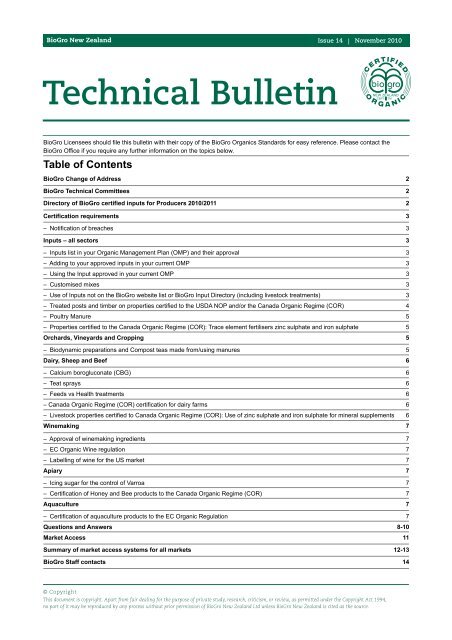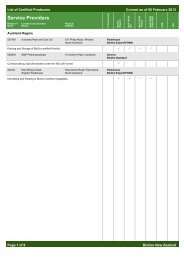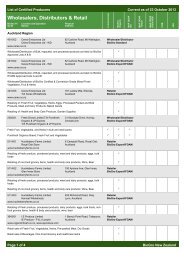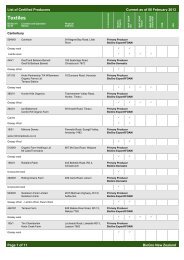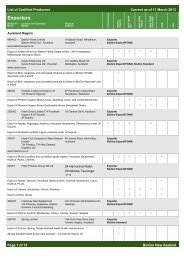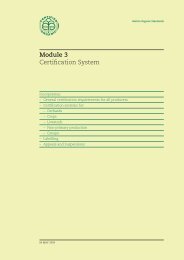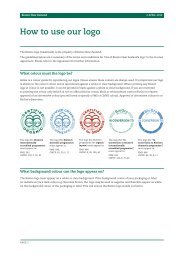Create successful ePaper yourself
Turn your PDF publications into a flip-book with our unique Google optimized e-Paper software.
<strong>BioGro</strong> New Zealand <strong>Technical</strong> <strong>Bulletin</strong> Issue 14 | November 2010<strong>BioGro</strong> Change of AddressAs from the 17th November 2010, <strong>BioGro</strong> will be located at Level 5, 156-158 Victoria Street, Wellington. Our PO Box number andphone numbers will stay the same.<strong>BioGro</strong> <strong>Technical</strong> Committees<strong>BioGro</strong> is forming <strong>Technical</strong> Committees for the main organic production sectors including kiwifruit, pipfruit, dairy, sheep and beef,viticulture and winemaking, cropping, processing, aquaculture, input supply, compost supply, health and body care, retail, wholesale,and export. The <strong>Technical</strong> Committees include representatives from those sectors, and provide input into:• Managing export regulations and standards;• Ongoing review and development of the <strong>BioGro</strong> Standards - both existing and new areas of the standards, and best organicpractices in New Zealand;• Communications with <strong>BioGro</strong> certified producers, sector groups, and other stakeholders of key issues, changes, anddevelopments in organic standards, regulations, and markets.The Livestock and Dairy <strong>Technical</strong> Committee is operating and its members are Glenn Mead (sheep and beef), John Vosper (dairy),Joy McLeod (poultry, livestock auditor), Viv Cruickshank (dairy auditor), and Seager Mason (<strong>BioGro</strong> <strong>Technical</strong> Director). Thiscommittee is currently dealing with the following issues:• Meat export requirements;• Feed rules for C0 and C1 conversion dairy farms;• Poultry housing requirements;• Review of the <strong>BioGro</strong> livestock and dairy standards;• Input approvals.Certified producers and stakeholders in the livestock and dairy sectors are free to contact any members of this <strong>Technical</strong> Committee atany time to raise issues or provide constructive input for the committee.Directory of <strong>BioGro</strong> Certified Inputs for Producers 2010/2011The new Directory for 2010 / 2011 has been issued to all certified producers and lists all the <strong>BioGro</strong> certified inputs from 1/8/10 to31/7/11 by both active/main ingredient and supplier. The previous directory (2009 / 2010) should no longer be used.The Directory is very useful for certified producers to look for suitable <strong>BioGro</strong> certified inputs and to record their check on currentcertification when inputs are purchased and used. This is an alternative to checking the <strong>BioGro</strong> website list or obtaining a copy of thecurrent <strong>BioGro</strong> certificate.The Directory is available from the <strong>BioGro</strong> office – <strong>BioGro</strong> licensees first copy free and extra copies $17.50, <strong>BioGro</strong> members allcopies $15.50, non-members all copies $52.00, all prices are exclusive of GST.New products certified after August 2010 will be included into updates that will be published as needed.2 of 14
<strong>BioGro</strong> New Zealand <strong>Technical</strong> <strong>Bulletin</strong> Issue 14 | November 2010Certification requirementsNotification of breachesPlease note that all certified producers are required to inform us of breaches of the standards, refer <strong>BioGro</strong> Organic Standards Module3 Section 7.4. Over the last year we have had several cases of applications of prohibited materials onto certified properties, and ofresidues of prohibited materials being detected either here in New Zealand or overseas in certified products. If you become aware of abreach of the standards including the above relating to your property or products, then you must inform us immediately so that we canwork with you to resolve that, including where necessary informing markets.Inputs – all sectorsInputs list in your Organic Management Plan (OMP) and their approvalOverseas market access requirements have meant a change to the way that inputs in your Organic Management Plan are approved by<strong>BioGro</strong>. All inputs to your property whether they are restricted or permitted must now be listed and approved by <strong>BioGro</strong> before use.The most efficient way to do this is to list all inputs you intend to or may need to use over the coming year at your renewal - avoidingthe need to seek approvals later. A spreadsheet entitled OMP Inputs Approval Form is available on the <strong>BioGro</strong> website to use for this.Restricted inputs may still carry conditions for use or require extra justification but otherwise the approval process is the same forpermitted and restricted inputs. Approval by <strong>BioGro</strong> of your OMP inputs list will provide you with the assurance that the inputs youintend to use are compliant with all markets your products will or may access.Adding to your approved Inputs list in your current OMPIf during the year you need to use a permitted or restricted input that is not listed in your current OMP then you need to have itapproved and added to your OMP before you use it. You can do this:• By email to your auditor or the <strong>BioGro</strong> office, or• By completing an OMP Inputs Approval Form available on the website, or from the office or your auditor, or• By completing a “Change to OMP” form available on the website, or from the office or your auditor.Send your application to the email address approvals@biogro.co.nz to ensure your application is prioritised.Using the Inputs approved in your current OMPOnce you have approval of your current OMP inputs list then you can use those listed inputs over the coming year without any furtherneed to contact your auditor or the office. Before using an input check again that the product has current <strong>BioGro</strong> certification (from theInputs Directory or <strong>BioGro</strong> website) or it has been assessed and you have current written approval from <strong>BioGro</strong>. Your auditor will verifythe inputs you have used at your annual audit.Customised mixesSome certified Input Suppliers have “Customised Mixes” on their certificate. In order to have this on their certificate they must have aclear written procedure, approved by <strong>BioGro</strong>, that they follow to make mixes including who takes responsibility and signs off on anymixes made, and evidence of staff training and awareness which covers this. The customised mixes can only contain ingredients whichhave current <strong>BioGro</strong> certification or written approval, the formulation must be agreed with the <strong>BioGro</strong> licensee who it is being made for,and it must be listed in that licensee’s current OMP. If the customised mix contains any restricted ingredients then <strong>BioGro</strong>’s approvalfor this must also be included in the current OMP.Use of Inputs not on the <strong>BioGro</strong> website list or in the <strong>BioGro</strong> Input Directory (including livestock treatments)There may be inputs that you would like to use which do not have current <strong>BioGro</strong> certification. This may be because:• certification has been discontinued, or• certification has not yet been renewed, or• a particular input is not available from a certified supplier in your area, or• a particular input or a livestock treatment is not yet available as a certified product, or• you would like to trial a new type of input product.3 of 14
<strong>BioGro</strong> New Zealand <strong>Technical</strong> <strong>Bulletin</strong> Issue 14 | November 2010In these cases contact Lucia (lucia@biogro.co.nz) or Nicolas (nicolas@biogro.co.nz) at the <strong>BioGro</strong> office and supply the specificationsheet and GMO declarations (if applicable). If the input is acceptable they will email or fax you written approval to use it for a specifiedperiod. There may be a charge to cover the work involved in assessing the input if it is a multi-ingredient product and involvesextensive research.If you use an input which doesn’t have current <strong>BioGro</strong> certification/written approval then a noncompliance or potentially a critical noncompliancewill be raised against your operation, and we need to report to NZFSA if you are on the export programme. We will thenendeavour to assess that input for compliance at the time of use. The outcome of this assessment may result in a market restriction foryour products and/or your certified land returning to registration for at least some markets. If we can’t obtain the complete formulationand production process for that input then it must be treated as a prohibited input and all affected land and products will losecertification. This is a very distressing situation and can be avoided by not using non certified/approved inputs.Treated posts and timber on properties certified to the USDA NOP and/or the Canada Organic Regime (COR)This notification updates our previous notification on treated posts and timber dated 26 June 2009, and the notifications on treatedposts and timber in <strong>Technical</strong> <strong>Bulletin</strong> Issue 12 November 2009 and <strong>Technical</strong> <strong>Bulletin</strong> Issue 13 May 2010.For properties certified to, or in conversion to, the USDA NOP, posts and timber treated with materials not listed as allowed in theUSDA NOP, including new and reused treated posts and timber already on the property, can not be used for new installations orreplacement purposes.For properties certified to, or in conversion to, the Canada Organic Regime, posts and timber treated with materials not listed asallowed in the COR can not be brought onto and used on the property, but treated posts and timber already on the property can bereused within the property.The above prohibitions must be applied to all properties certified to or in conversion to the NOP, and/or certified to or in conversion tothe COR, including dairy and livestock farms, orchards, vineyards, and cropping farms.For properties certified / in conversion to the NOP and/or the COR, existing in use treated posts and timber such as in existing fences,crop structures, livestock housing, and fruit bins on the property are acceptable, ie they do not need to be replaced with alternativematerials.Current OMPs for NOP certified / in conversion properties must address how the property is managed without the use of treated postsand timber, including without both new and recycled treated posts and timber, for new installations and replacement purposes as from1 July 2010.Current OMPs for COR certified / in conversion properties must address how the property is managed without bringing new andrecycled treated posts and timber onto the property for new installations and replacement purposes as from 1 July 2010.Properties certified / in conversion to the USDA NOP and/or the COR must be fully compliant with the above as from 1 July 2010.The NOP regulation requirements for this can be viewed at www.ams.usda.gov/nop then select Regulations then select ElectronicCode of Federal Regulations ( eCFR ) (Standards) website. Refer the following clauses:• NOP 205.105 (a) To be sold or labeled as “100 percent organic,” “organic,” or “made with organic (specified ingredients or foodgroup(s)),” the product must be produced and handled without the use of:(a) Synthetic substances and ingredients, except as provided in §205.601 or §205.603;(b) Nonsynthetic substances prohibited in §205.602 or §205.604;• 205.206 (f) The producer must not use lumber treated with arsenate or other prohibited materials for new installations orreplacement purposes in contact with soil or livestock.• NOP 205.601 which lists the allowed synthetic materials for primary production.• NOP 205.602 which lists the natural materials which are prohibited for primary production.The COR regulation requirements for this can be viewed at www.tpsgc-pwgsc.gc.ca/cgsb/on_the_net/organic/index-e.htmlthen select CAN/CGSB–32.310:Clause 5.2.2 The use of posts or wood treated with materials other than those in CAN/CGSB-32.311, Organic Production Systems— Permitted Substances Lists, is prohibited.a. Continued use and recycling of existing (prohibited) posts within the farm are allowed.b. Acquisition of any additional material with these wood treatments is prohibited for new installations or replacement purposes.Exceptions may be granted in vast rangeland and semi-arid regions, and will consider the availability of alternate materials.Also select CAN/GSB-32.311 for the Permitted Substances Lists.Also refer the Questions and Answers section of this <strong>Technical</strong> <strong>Bulletin</strong> for Q&As on this issue.4 of 14
<strong>BioGro</strong> New Zealand <strong>Technical</strong> <strong>Bulletin</strong> Issue 14 | November 2010Poultry manureThe <strong>BioGro</strong> Standards require all raw manures to be hot composted before application onto certified land. This requirement is toenable good management of raw manures and soils, reduce the likelihood of leaching, and assist breakdown of possible contaminantsin manures from non-certified sources.Poultry manure from non-certified barn or free range poultry farms can be considered for use as an ingredient in composts to be usedon certified properties. Manure from caged (battery) systems can not be used.Before we can approve a particular source of barn or free range poultry manure we must assess the feed and management of thatpoultry for acceptability and risks of contamination. If any of the feed ingredients are at risk of GMO presence / contamination (egimported soy, corn, canola, and cotton byproducts) then we must assess that risk and if necessary we require testing to measure therisk.At this stage there are some sources of non-certified poultry manures in New Zealand which we are not able to approve because ofinsufficient information being made available by the company(s) involved on the possible or potential GMO status of the feed used ontheir farms.Properties certified to the Canada Organic Regime (COR): Trace element fertilisers zinc sulphate and iron sulphateThe Canada Organic Regime (COR) prohibits the use of synthetic zinc sulphate and iron sulphate as fertilisers where thesecompounds have been produced using sulphuric acid. Under our input certification programme we only certify inputs which complywith all market regulations, hence we have not been able to certify these forms of these two trace elements as fertilisers for the 2010 /2011 season.There are certified trace element products which supply zinc and iron available, refer to the Inputs Directory for 2010 / 2011.Also, because it is only the Canada regulation which prohibits the above forms of zinc and iron as trace element fertilisers then forproperties not certified to COR we can consider applications to use these forms of zinc and iron on a case by case basis. However wedo not recommend this for properties considering certification to COR in the near future.Orchards, Vineyards and CroppingBiodynamic preparations and Compost teas made from/using manuresIn <strong>Technical</strong> <strong>Bulletin</strong>s 12 and 13 we notified that biodynamic preparations and compost teas made from/using raw manures notcomposted to the NOP requirements, must comply with the USDA NOP restrictions that they may only be:(i) applied to land used for a crop not intended for human consumption; or(ii) incorporated into the soil not less than 120 days prior to the harvest of a product whose edible portion has direct contact withthe soil surface or soil particles; or(iii) incorporated into the soil not less than 90 days prior to the harvest of a product whose edible portion does not have directcontact with the soil surface or soil particles.Please note that these requirements only apply to properties certified to the USDA NOP.5 of 14
<strong>BioGro</strong> New Zealand <strong>Technical</strong> <strong>Bulletin</strong> Issue 14 | November 2010Dairy, Sheep and BeefCalcium borogluconate (CBG)<strong>BioGro</strong> certified/approved calcium borogluconate (CBG) products are now allowed for all markets, including USDA NOP. This changefollows USDA reviewing their previous advice to NZFSA on the use of CBG and electrolyte solutions containing calcium, and nowadvising NZFSA that farms certified to the NOP in New Zealand are able to use these materials as electrolytes under the NOP providedthe formulation of any product containing them meets the requirements of the NOP.This change was notified by us to all certified farmers on 8 September 2010 and implemented as from that date. Before you treat anystock with CBG or any other calcium electrolyte you must ensure that:• The product has <strong>BioGro</strong> certification or written approval, and• Your current <strong>BioGro</strong> approved OMP (Organic Management Plan) includes use of this product.Contact your auditor or the <strong>BioGro</strong> office for information on which CBG products have current <strong>BioGro</strong> approval.Teat spraysTeat spray products must be <strong>BioGro</strong> certified or have <strong>BioGro</strong> written approval, and must be listed in your current approved OMP.Please check the Input Directory, or with your auditor or the <strong>BioGro</strong> office for teat spray products which are certified or approved for allmarkets including the USDA NOP.If you have teat spray products on your property which do not have current <strong>BioGro</strong> certification / approval for the 2010 / 2011 seasonthen they can not be used, and must be removed from your property.Feeds vs Health treatmentsThe export regulations, particularly the NOP, have separate rules for allowed feeds vs allowed health treatments. For the NOP, 100% ofagricultural ingredients in livestock feeds must be NOP certified, whereas for health treatments non-NOP certified agriculturalingredients can be allowed.Anything offered on a routine basis to certified stock, in the absence of that/those stock needing direct emergency treatment, must beconsidered to be feed. This includes things such as tonics which are given to stock at maintenance dose rather than during specificperiods of stress to promote good health, they must also be considered as a feed and hence 100% of the ingredients must be NOPcertified.Where a product is only used for direct emergency treatment or during specific and limited periods of stress then the health treatmentrules apply and some non-NOP certified ingredients may be able to be included in that product.Certified inputs for livestock which can only be used for health treatments (ie for direct emergency treatments) have this restrictionlisted on the <strong>BioGro</strong> certificate, the website, and the Input Directory, as “This product can’t be offered free choice to organic animals ona routine basis”.In some cases there may be different formulated products (eg a cider vinegar product) where one product is made with 100% NOPcertified ingredients and hence is permitted and can be used as a feed and/or a health treatment, while another product of this type hassome non-NOP certified ingredients hence has the above restriction and can only be used as a health treatment.Canada Organic Regime (COR) certification for dairy farmsNote that Fonterra have informed us that at this stage they do not require organic dairy farms supplying them to have CORcertification.Livestock properties certified to the Canada Organic Regime (COR): Use of zinc sulphate and iron sulphate for mineralsupplementsRefer above, the COR prohibits the use of synthetic zinc sulphate and iron sulphate as fertilisers where these compounds have beenproduced using sulphuric acid.However these forms of zinc and iron sulphate are allowed under COR as mineral supplements for livestock in feeds.6 of 14
<strong>BioGro</strong> New Zealand <strong>Technical</strong> <strong>Bulletin</strong> Issue 14 | November 2010WinemakingApproval of winemaking ingredientsAt your annual renewal of certification <strong>BioGro</strong> will email you an electronic copy of your current OMP list of wine making ingredients thatwe have on file. Please review the list and email the spreadsheet back with any changes to nicolas@biogro.co.nz for approval at thesame time as your submit your renewal. We will review the list and send back the approved list that you can use for the next yearwithout any further need to contact the office or the auditor.EC Organic Wine regulationThe EC have withdrawn their proposal for including organic wine making in the EC Organic Regulation. They have done this becausethe EC and some of the EU member states could not agree on some aspects of the final regulation.It is hoped that this work will be resumed at some stage and the differences will be resolved. In the meantime wine made using sulphurcan only be marketed in EU labelled as “wine made from certified organic grapes”. Please contact the <strong>BioGro</strong> office for other productionand labelling requirements for wine to be marketed in the EU.Labelling of wine for the US marketWine made using sulphur can only be marketed in US labelled as “wine made with certified organic grapes”. Please note the differencebetween the EC (requires the word “from”) and US (requires the word “with”) labelling.Please contact the <strong>BioGro</strong> office for other production and labelling requirements for wine to be marketed in US.ApiaryIcing sugar for the control of VarroaThe use of icing sugar as a control for Varroa has been approved by NZFSA for exports under the OOAP.Use will be subject to the same conditions as for supplementary feeding of sugar, ie:- certified organic sugar must be used, and- the sugar can only be used during the period after the last honey harvest of the season and up to 15 days before the nextnectar flow, and- with written approval from NZFSA.Certification of Honey and Bee products to the Canada Organic Regime (COR)Apiculture is included in the scope of the COR, and the COR requirements for certified organic apiculture can be downloaded from:http://www.tpsgc-pwgsc.gc.ca/cgsb/on_the_net/organic/index-e.htmlAquacultureCertification of aquaculture products to the EC Organic RegulationThe EC amendment to add organic aquaculture to the EC organic regulation has now been issued entitled EC 710/2009. This amendsthe EC organic regulations 834/2007 and 889/2008 to include aquaculture production, and was implemented on 1 July 2010.A copy of EC 710/2009 is available from the <strong>BioGro</strong> office, or can be downloaded from:http://eur-lex.europa.eu/LexUriServ/LexUriServ.do?uri=OJ:L:2009:204:0015:0034:EN:PDFNote that Aquaculture is not currently covered by the NZFSA OOAP. If you are interested in exporting certified organic aquacultureproducts to EU then please contact the <strong>BioGro</strong> office for information on the new market access requirements.7 of 14
<strong>BioGro</strong> New Zealand <strong>Technical</strong> <strong>Bulletin</strong> Issue 14 | November 2010Questions and AnswersQuestions and Answers on the prohibition of treated posts and timber on properties certified to the USDA NOP and/or the COR:Refer notification on this in the Inputs – all sectors section of this <strong>Technical</strong> <strong>Bulletin</strong>. The following questions and answers apply toproperties which are certified / in conversion to the NOP and/or COR. They do not apply to properties which are certified / in conversionto <strong>BioGro</strong> but are not also certified / in conversion to the NOP and/or COR, but these properties may elect to comply with theserequirements if they wish.Q: Which types of production are affected by this ruling?A: All primary production properties which are certified / in conversion to the NOP and/or COR, including dairy farms, sheep and beeffarms, cropping farms, orchards, and vineyards.Q: Which uses of posts and timber are affected by this ruling?A: All uses including fences (end assemblies, stays, posts and battens), livestock housing (calf houses, milking sheds, hay sheds,stock yards), crop support and artificial shelter structures on orchards and vineyards, crop structures such as greenhouses andraised beds, packing sheds, and bins and other containers for harvesting fruit, grapes, vegetables and other crops.Q: Does this affect existing fences, buildings, crop structures, and bins etc on my NOP or COR certified / in conversion toproperty ?A: No, existing fences, buildings, crop structures, and bins etc are ok, this ruling applies to repairs of existing fences, buildings, cropstructures, and bins etc, and to new fences, buildings, crop structures, and bins etc.Q: Can the runners underneath, or any other part of, new fruit bins brought onto the property be treated timber?A: No. Existing bins in use which were constructed using treated timber for any parts of them can continue to be used, but new binscan not be constructed using treated timber for any parts of those bins.Q: Boundary fences are legal requirements and are usually maintained also by the neighbour who may not be certified / inconversion to the NOP and/or COR. Can treated posts and timber be used for boundary fences for properties which grazecertified livestock (dairy farms, sheep and beef farms, orchards or vineyards which graze livestock) provided an internalfence using allowed materials such as steel posts and wires is run inside the NOP / COR certified / in conversion propertyand will ensure that the certified livestock can not contact the boundary fence ?A: Yes you can apply to <strong>BioGro</strong> to decertify that strip of land. The internal fence must be permanent and effective (such as apermanent electric fence) so the stock can’t graze to the treated post boundary fence, typically the decertified strip should be atleast 1m wide. Just outriggers on the boundary fence are not acceptable. We would also encourage planting of trees in thedecertified strip.Q: Can boundary fences and artificial shelter constructions on boundaries of orchards, vineyards, and cropping propertiesbe built or maintained using treated posts and timber provided there is a buffer strip inside the NOP / COR certified / inconversion property ?A: Yes you can apply to <strong>BioGro</strong> to decertify that strip of land. If certified livestock graze that property then the Q & A immediatelyabove applies. If certified livestock don’t graze that property then an internal fence is not required but there must be a buffer zoneinside the boundary fence / artificial shelter construction such as a headland, ideally at least 4m wide.Q: Can fences and artificial shelter constructions within certified/conversion properties such as orchards, vineyards, andcropping properties be built or maintained using treated posts and timber ?A: No we don’t believe it is practical, or would be acceptable to USDA, to have decertified areas within a certified property for thisreason.Q: Can buildings such as machinery and implement sheds be built using treated posts/poles and timber ?A: If the area in and around the building can effectively be a decertified area, ie certified livestock and products can not / do not enterthat area, then this can be considered. In general this will only be possible when such buildings are on the perimeter, or outside, ofthe certified area of the property. In general it will not be able to be considered when the building is within the certified area of theproperty. We encourage NOP and COR certified farms, orchards, and vineyards to look for ways of building without using treatedposts/poles and timber in order to meet the spirit of these export regulations.8 of 14
<strong>BioGro</strong> New Zealand <strong>Technical</strong> <strong>Bulletin</strong> Issue 14 | November 2010Q: What about hay and feed sheds, either within a certified property, or outside of a certified property ?A: Hay sheds and feed sheds are storing certified feed so treated posts/poles and timber can not be used to repair and/or build hayand feed sheds.Q: What about packing sheds, either within a certified property, or outside of a certified property ?A: If the area in and around the packing shed can effectively be a decertified area then this can be considered. In general this will onlybe possible when the packing shed is on the perimeter, or outside, of the certified area of the property. In general it will not be ableto be considered when the packing shed is within the certified area of the property. We encourage NOP and COR certified farms,orchards, and vineyards to look for ways of building without using treated posts/poles and timber in order to meet the spirit of theseexport regulations.Q: Can treated posts and/or timber be used to build or repair stock yards and stock loading ramps?A: No, because the certified stock can/will be in contact with them at times.Q: Can beehives on the property be wholly or partly constructed using treated timber, such as the runners underneath thehives ?A: If the hive(s) is permanently on the certified property then repairs, or new hives made or brought in, can not use any treated timber.If the hive(s) are brought onto the certified property for the pollination period only then removed then they may contain treatedtimber.Q: Can I move an existing fence and reuse the treated posts, or dismantle a crop structure or livestock housing and reuse thetreated posts / timber elsewhere on my certified property ?A: If your property is NOP certified / in conversion then no. If your property is COR certified / in conversion and not NOP certified /conversion then theoretically you can do the above. However we don’t recommend this, as in general properties certified / inconversion for North American markets should comply with both the NOP and the COR to ensure that both markets are open toyour products.Q: If I have new and/or already used treated posts and timber stored on my property can I use these after 1 July 2010 ?A: If your property is NOP certified / conversion then no. If your property is COR certified / conversion and not NOP certified /conversion then theoretically you can do the above. However we don’t recommend this, as in general properties certified /conversion for North American markets should comply with both the NOP and the COR to ensure that both markets are open toyour products.Q: If I have new or old or broken etc treated posts and/or timber stored on my property which aren’t in use and won’t beused, do I have to remove them ?A: We can’t require them to be removed but suggest you should remove them asap to simplify management and auditing of theseNOP and COR requirements. If new or old treated posts and/or timber are stored on your property and won’t be used then typicallyyour auditor at your annual audit will issue an RFA to remove them at some stage over the following year.Q: Cross arms on crop support structures such as for kiwifruit and pipfruit are not in contact with soil or certified livestock,can they be replaced or repaired using new treated timber ?A: It could be argued that this meets the wording of the NOP, but the USDA have made it clear to NZFSA that treated posts and timbercan not be used for any uses on NOP certified / conversion areas of a property. The COR doesn’t allow this so our replyimmediately above also applies, ie we recommend that properties certified / conversion for North American markets should complywith both the NOP and the COR to ensure that both markets are open to your products.Q: Can treated posts covered with a compliant material such as a plastic be used ?A: No, our understanding is that treated posts, even if covered in some way, can not be used on NOP and COR certified / conversionproperties.Q: Can we use posts and timber not tanalised (copper chrome arsenate) but treated with other treatments ?A: At this stage we are not aware of any other post and timber treatments being used in New Zealand which comply with the NOP and/or COR. Note that some materials such as copper hydroxide, sodium tetraborate, and sodium octaborate which are listed asallowed in the NOP may be worth considering as timber preservatives, but this would require our prior assessment and writtenapproval.9 of 14
<strong>BioGro</strong> New Zealand <strong>Technical</strong> <strong>Bulletin</strong> Issue 14 | November 2010Q: Where can I check if a treatment would be compliant?A: First find out all ingredients (100% formulation) of that treatment then check with the <strong>BioGro</strong> office.Q: My property is <strong>BioGro</strong> certified but not certified or in conversion to the USDA NOP or the COR at the moment. If in future Idecide to produce for the US and/or Canada markets, how does the use of treated timber on my property affect myconversion to the NOP and/or the COR ?A: You will need to show compliance to these regulations, ie as per our 26 June 2009 notification, <strong>Technical</strong> <strong>Bulletin</strong>s 12 and 13, andthis update notification. If you use new or recycled treated posts and/or timber after 1 July 2010 then you will not be able to gainNOP certification on your products until at least 3 years after that use. If you use new or recycled (other than recycled within yourproperty) treated posts and/or timber after 1 July 2010 then you will not be able to gain COR certification on your products until atleast 3 years after that use.Q: I want to register for conversion to NOP and/or COR certification after 1 July 2010. How will this affect my registrationdate, will my past use of treated posts and timber be considered as a last prohibited input?A: Yes, see answer to previous question. Your past use of treated posts and timber will be judged against what was allowed at thetime.Q: My property is certified to the USDA NOP, can I withdraw from NOP certification, then make repairs or build newA: Yes.constructions with treated posts and timber, then reconvert over 3 years to being NOP certified again ?Q: My orchard is certified to the USDA NOP, if I replace say just one post in the crop support structure of a row can I justwithdraw that row only from NOP certification or do I have to withdraw the whole block ?A: The whole block will lose certification because we don’t believe it is practical, or would be acceptable to USDA, to decertify a smallarea within a certified orchard block. Also see next Q&A re COR.Q: My property is certified to the COR, can I withdraw part or all of my property from COR certification, then make repairs orbuild new constructions with brought in treated posts and timber, then reconvert over 3 years to being COR certifiedagain ?A: No, refer: CAN/CGSB–32.310 clause 5.1.6: Production units shall not be alternated between organic and non-organic productionmethods, and http://www.inspection.gc.ca/english/fssa/orgbio/comqueste.shtml which provides Q&As on COR, note Q6. Thismeans that part or all of a COR certified property can not be withdrawn from COR certification for a purpose such as using broughtin treated posts and/or timber then returned to COR certification.Q: What are the alternatives to treated post and timber ?A: NOP and COR compliant fencing and building materials include:• Metal such as steel and aluminium, including with galvanised and other coatings;• Concrete;• Plastic;• Untreated posts and timber which are suitable for that purpose. Examples are untreated timber (eg douglas fir, macrocarpa,some eucalypts, untreated pine) used for building framing where allowed under building codes, and ground durable timbers (egmacrocarpa, robinia, chestnut, and some eucalypts) for posts/poles and raised beds;• Posts and timber treated with materials which are suitable for that purpose and are listed as allowed for this purpose in the NOPor COR respectively.Organics Aotearoa NZ (OANZ) have compiled a list of alternatives which are available, called “Over the Fencepost”, and arerunning workshops on this throughout NZ during November 2010. Refer www.oanz.org.nz for more details.Q: Can imported posts / timber which have been heat treated or fumigated be used ?A: Heat treated posts / timber can be used. Fumigated posts / timber in general can’t be used, but <strong>BioGro</strong> can consider this on a caseby case basis depending on the fumigant to be used and the process.10 of 14
<strong>BioGro</strong> New Zealand <strong>Technical</strong> <strong>Bulletin</strong> Issue 14 | November 2010Market AccessMarket access – NZFSA OOAP for Japan:A new version of the NZFSA OOAP <strong>Technical</strong> rules was issued on 16 November 2009, but this new version doesn’t yet cover productsexported to Japan under the OOAP because some of the allowed inputs are still being evaluated for equivalency. In the meantime, anyproducts exported to Japan must continue to be produced to the previous version (i.e version 6.2).Market access – Exports of pipfruit to Taiwan:Certification of organic products marketed in Taiwan is controlled by Taiwan’s organic regulation which was implemented on 31January 2009. Access to the Taiwan market for <strong>BioGro</strong> certified exporters is provided by certification under <strong>BioGro</strong>’s Export and IFOAMAccredited programme, and certified exporters must apply to <strong>BioGro</strong> (not to NZFSA as is required for EU and US) for an exportverification/certificate for each shipment.Please note that organic pipfruit exported to Taiwan must also meet all industry requirements including the MAF Biosecurity NewZealand phytosanitary programme called Apples to Taiwan. This is available from the MAF Biosecurity New Zealand website:http://www.biosecurity.govt.nz/PlantComplianceProgrammesMarket access – Exports of aquaculture products to EUThe EC amendment to add organic aquaculture to the EC organic regulation has now been issued entitled EC 710/2009. This amendsthe EC organic regulations 834/2007 and 889/2008 to include aquaculture production, and was implemented on 1 July 2010.A copy of EC 710/2009 is available from the <strong>BioGro</strong> office, or can be downloaded from:http://eur-lex.europa.eu/LexUriServ/LexUriServ.do?uri=OJ:L:2009:204:0015:0034:EN:PDFNote that Aquaculture is not currently covered by the NZFSA OOAP. If you are interested in exporting certified organic aquacultureproducts to EU then please contact the <strong>BioGro</strong> office for information on the new market access requirements.Market access – South KoreaCurrently South Korean regulations on organic foods only cover primary products such as fresh fruit. These regulations areadministered by the South Korean Ministry for Food, Agriculture, Forestry and Fisheries (MIFAFF). A new MIFAFF regulation onlabelling of organic processed (non-primary) products was due to enter into force on January 1, 2010 but this has been delayed until atleast January 1, 2013, to allow time for the Korean authorities to consider equivalence of other country systems.<strong>BioGro</strong>’s Export and IFOAM Accredited certification programme will continue to provide access to South Korea for processed productsin the meantime.11 of 14
<strong>BioGro</strong> New Zealand <strong>Technical</strong> <strong>Bulletin</strong>Issue 14 | November 2010Summary of market access systems for all markets:Market Access system for exported products References OtherEU - EC 834/2007and 889/2008Plant and livestock products – fullorganic (plant and livestock products)and conversion (plant products only):Certification by <strong>BioGro</strong> as a Third PartyAgency (TPA) for the New Zealand FoodSafety Authority Official Organic AssuranceProgramme (NZFSA OOAP).www.nzfsa.govt.nz/organicsProcessed products usingimported ingredients: contact<strong>BioGro</strong> for NZFSA recertificationrequirements.Other products: Certification by <strong>BioGro</strong>www.biogro.co.nzUSA – USDA NOPPlant and livestock products (excludinghoney) – full organic: Certification by<strong>BioGro</strong> as a TPA for the NZFSA OOAP.www.nzfsa.govt.nz/organicswww.ams.usda.gov/nopNB: Because access to US isthrough the NZFSA OOAP,<strong>BioGro</strong>’s recognition for theUSDA NOP is listed as follows(not in the USDA accreditedcertifiers list)Refer <strong>BioGro</strong> Standards and<strong>Technical</strong> <strong>Bulletin</strong>s forsupplementary requirements.Processed products usingimported ingredients: contact<strong>BioGro</strong> for NZFSA recertificationrequirements.www.ams.usda.gov/AMSv1.0/ams.fetchTemplateData.do?template=TemplateD&topNav=NationalOrganicProgram&leftNav=NationalOrganicProgram&page=NOPNewZealand&description=New%20Zealand&acct=nopgeninfoOther products and Transitionalcertification: Certification by <strong>BioGro</strong>www.biogro.co.nzJapan – JASOrganicPlant and livestock products – fullorganic and conversion:1. Fresh, processed, and bulk plant andlivestock products, labelled with the JASOrganic logo: Certification by <strong>BioGro</strong> as aRegistered Foreign CertificationOrganisation with Japan MAFF; orwww.biogro.co.nzwww.maff.go.jp/soshiki/syokuhin/hinshitu/e_label/index.htm has<strong>BioGro</strong>’s RFCO listing withJapan MAFFwww.nzfsa.govt.nz/organicsNB: JAS has supplementaryrequirements for JAScertification including trainingrequirements. Contact <strong>BioGro</strong>for details.2. Bulk plant products only, JAS Organiclogo can not be applied: Certification by<strong>BioGro</strong> as a TPA for the NZFSA OOAP.Other products: Certification by <strong>BioGro</strong>www.biogro.co.nz12 of 14
<strong>BioGro</strong> New Zealand <strong>Technical</strong> <strong>Bulletin</strong>Issue 14 | November 2010Market Access system for exported products References OtherTaiwanPlant and livestock products – full organic(plant and livestock products) andconversion (plant products only):Certification by <strong>BioGro</strong> as a Third PartyAgency (TPA) for the New Zealand FoodSafety Authority Official Organic AssuranceProgramme (NZFSA OOAP).www.nzfsa.govt.nz/organicsLivestock products must becertified to the NOP to cover allthe Taiwan requirements.Certified exporters must apply to<strong>BioGro</strong> for an export certificate.Processed products usingimported ingredients: contact<strong>BioGro</strong> for NZFSA recertificationrequirements.Other products: Certification by <strong>BioGro</strong>www.biogro.co.nzCanada - COR(Canada OrganicRegime)Plant and livestock products – fullorganic: Certification by <strong>BioGro</strong> as a CFIAaccredited certification body.www.inspection.gc.ca/english/fssa/orgbio/orgbioe.shtmlNB: The COR hassupplementary requirements, tobe notified.Other products: Certification by <strong>BioGro</strong>www.biogro.co.nzQuebecPlant and livestock products (excludinghoney) – full organic: Certification by<strong>BioGro</strong> through <strong>BioGro</strong>’s recognition byConseil des Appellations Réservées et desTermes Valorisants (CARTV).www.cartvquebec.com/EN/approval-bodies/approvedcertifying-bodies.aspTo be absorbed into COR.Other products: Certification by <strong>BioGro</strong>www.biogro.co.nzKoreaPlant and livestock products – fullorganic and conversion: Certification by<strong>BioGro</strong> through <strong>BioGro</strong>’s IFOAMAccreditation.www.biogro.co.nzwww.ifoam.orgwww.ioas.orgAlso see Market Access sectionabove.Other products: Certification by <strong>BioGro</strong>www.biogro.co.nzOther markets:Australia,Singapore, etcAll products: Certification by <strong>BioGro</strong>www.biogro.co.nzwww.ifoam.orgwww.ioas.orgCheck with your importer for anyspecific requirementsAll feedback and suggestions for this <strong>Technical</strong> <strong>Bulletin</strong>are welcome.Contact us:<strong>BioGro</strong> New Zealand LtdPO Box 9693Marion Square, Wellington, 6141Ph 04 801 9741 Fax 04 801 974213 of 14
<strong>BioGro</strong> New Zealand <strong>Technical</strong> <strong>Bulletin</strong>Issue 14 | November 2010<strong>BioGro</strong> staffEnquiry area Contact Position e-mailAccounts (invoices, payments etc) Hanna Nicholson Management Accountant hanna@biogro.co.nzApplications (New applications, Info packs) Eljay Maunder Events & Customer Services eljay@biogro.co.nzApplications (Renewals, Information) Sarah Johnstone Office Assistant sarah@biogro.co.nzAudit scheduling/ auditor allocation Eljay Maunder Events & Customer Services eljay@biogro.co.nz<strong>BioGro</strong> Merchandise (Standards, labels, stickers, gate signs) Hanna Nicholson Management Accountant hanna@biogro.co.nzCertification progress queries Sarah Johnstone Office Assistant sarah@biogro.co.nzCertification: Dairy Phillip Walsh Certification Officer phillip@biogro.co.nzCertification: Domestic programme Marcus Coomer Certification Officer marcus@biogro.co.nzCertification: Exporters - See sectors belowCertification:Health and Body Care (Including recipe and label approvals)Alannah Goile Certification Officer alannah@biogro.co.nzCertification:Inputs (including formulation and label approvals)Lucia Zanmonti <strong>Technical</strong> Manager lucia@biogro.co.nzNicolas Leneveu Certification Officer nicolas@biogro.co.nzCertification: Primary production (including label approvals) Sachin Ayachit Programme Manager sachin@biogro.co.nzCertification:Processed products (Including recipe and label approvals)Alannah Goile Certification Officer alannah@biogro.co.nzMarcus Coomer Certification Officer marcus@biogro.co.nzCertification: Service providers Nicolas Leneveu Certification Officer nicolas@biogro.co.nzCertification: Textiles (including label approvals) Alannah Goile Certification Officer alannah@biogro.co.nzCertification: Viticulture and Winemaking (Including recipe andlabel approvals)Certification: Wholesalers and Retailers (including labelapprovals)Nicolas Leneveu Certification Officer nicolas@biogro.co.nzMarcus Coomer Certification Officer marcus@biogro.co.nzCEO Michelle Glogau Chief Executive Officer michelle@biogro.co.nzCompliments and complaints Eljay Maunder Events & Customer Services eljay@biogro.co.nzDatabase Lakshmi Budaraju Data Information Officer lakshmi@biogro.co.nzExport Verification/Transaction Certificates Lakshmi Budaraju Data Information Officer exportcerts@biogro.co.nzExtensions to certificates Sachin Ayachit Programme Manager sachin@biogro.co.nzGeneral enquiries Sarah Johnstone Office Assistant sarah@biogro.co.nzMarket accessSeager Mason <strong>Technical</strong> Director seager@biogro.co.nzLucia Zanmonti <strong>Technical</strong> Manager lucia@biogro.co.nzAkiko NichollsJapan advisor – for enquiriesin Japanese re Japan accessakiko.nicholls@aco.net.auOMP input approval forms<strong>BioGro</strong> office Certification Officers approvals@biogro.co.nzGeoff Ledbrook Auditor geoff@tamahungagardens.co.nzHans Dirkse Senior Auditor bgaudit@clear.net.nzJared White Senior Auditor jared@ts.co.nzJoy McLeod Senior Auditor joywestwood@xtra.co.nzSimon Baylis Senior Auditor simonbaylis@yahoo.co.ukVivienne Cruickshank Auditor viv@earthbridge.co.nzRecertification of Products or Ingredients Alannah Goile Certification Officer alannah@biogro.co.nzSpokesperson Seager Mason <strong>Technical</strong> Director seager@biogro.co.nzWebsite (including licensee and input lists) Lakshmi Budaraju Data Information Officer lakshmi@biogro.co.nz14 of 14


